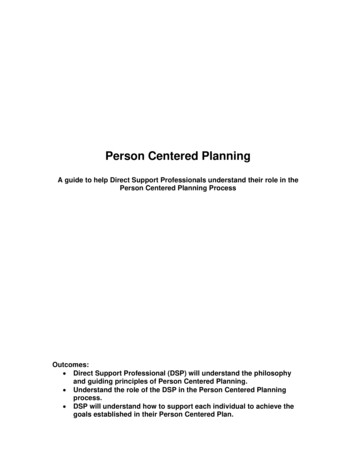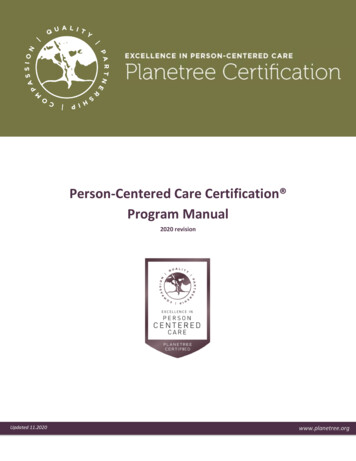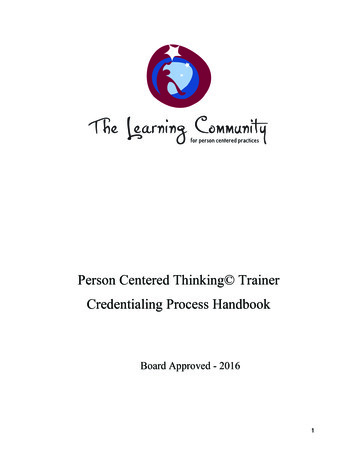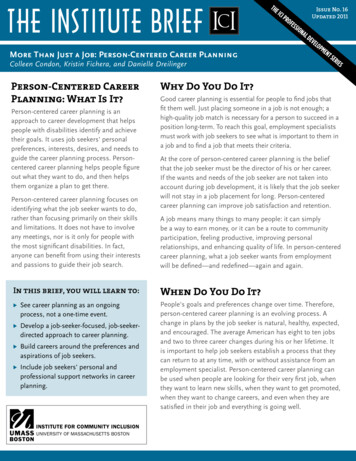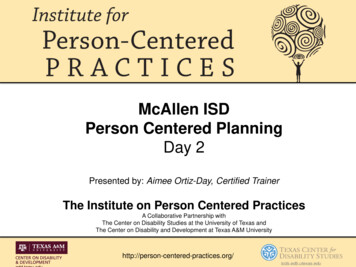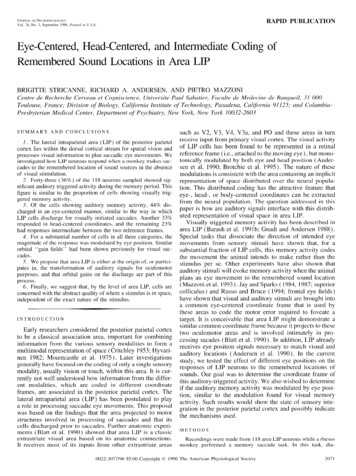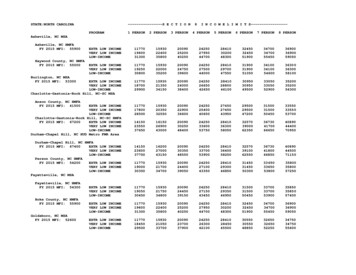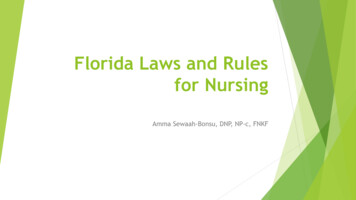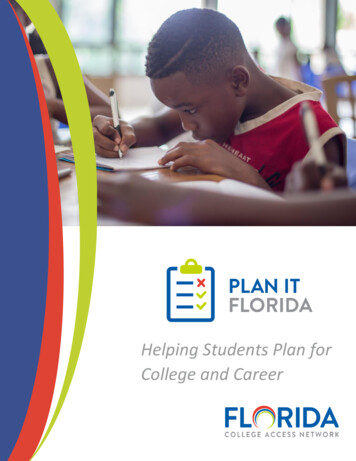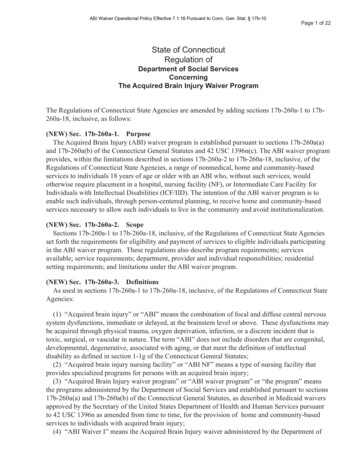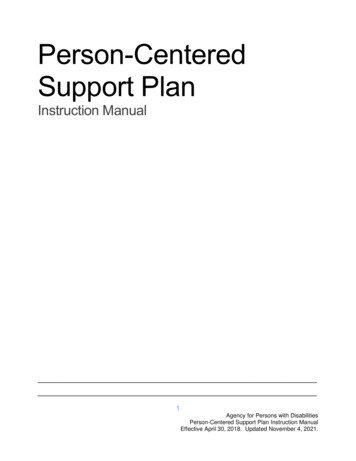
Transcription
Person-CenteredSupport PlanInstruction Manual1Agency for Persons with DisabilitiesPerson-Centered Support Plan Instruction ManualEffective April 30, 2018. Updated November 4, 2021.
Table of ContentsIntroduction to the Person-Centered Support Plan.3Overview of Person-Centered Planning .5Getting Ready for the Support Plan Meeting .12Support Plan Submission Timelines .13Support Plan in APD iConnect .14Identifying Information About the Individual and Supports .15My Life .19Employment .26Other Services Needed for Health and Safety .29What I Accomplished Last Year .38My Personal and Future Plans.40Personal Rights .45My Health .50Signature Page .54Updating the Support Plan .55Bill of Rights for Persons with Developmental Disabilities . Appendix AResident Rights for Individuals Living in APD Licensed Facilities . . Appendix B2Agency for Persons with DisabilitiesPerson-Centered Support Plan Instruction ManualEffective April 30, 2018. Updated November 4, 2021.
Person-Centered Support Plan InstructionsIntroduction to the Person-Centered Support PlanThis support plan was developed with feedback from Waiver Support Coordinators (WSCs),self-advocates, and other stakeholders. This support plan format fosters the WSC andConsumer-Directed Care Plus (CDC ) Consultant in engaging in person-centeredconversations with the individuals they serve.The support plan is a written tool that contains information provided by the consumer andthose that know the consumer the best regarding future goals and supports needed. Thesupport plan is the guiding document from which services are authorized and provided.The role of the WSC and CDC Consultant in the support planning process is to help theconsumer identify key information about themselves and to develop a vision for the future,while coordinating resources and supports to make the vision a reality. A completed supportplan is the result of the collaborative efforts of people chosen by the consumer. It identifiesinformed choices made by the consumer and provides mechanisms to implement actionsthat identify: Where the individual wants to live and with whom Employment and the opportunity to earn competitive wages How to be involved in the community The personal goals, accomplishments, or experiences the consumer would like toachieve How to meet health, behavioral, medical, or environmental needs; and How to address risks and follow up on incidentsThe support plan form is intended to guide the conversation between the WSC or CDC Consultant, the consumer, and those involved in the support planning process.Compliance with State and Federal RequirementsThe federal Centers for Medicare & Medicaid Services (CMS) authorized the iBudget Homeand Community-Based Services (HCBS) waiver program under 1915c of the Social SecurityAct. It also provides rules and requirements for waiver programs to operate. Federalregulations require every consumer on the iBudget waiver have a current support plan.CMS published updated HCBS regulations in 2014. These federal rules were designed toenhance the quality of HCBS by establishing a more outcome-oriented definition of theservices, based on the nature and quality of the individual’s experience. CMS identifiedadditional protections to group home residents to ensure full access to the benefits ofcommunity living.3Agency for Persons with DisabilitiesPerson-Centered Support Plan Instruction ManualEffective April 30, 2018. Updated November 4, 2021.
Federal rules require service planning for participants in Medicaid HCBS programs to bedeveloped through a person-centered planning process that addresses health, long-termservices, and support needs in a manner that reflects individual preferences and goals. Therules include six standards that all HCBS programs must meet.Six standards of HCBS:1) integration into the community2) individual choice3) individual rights4) autonomy5) choice regarding services and providers, and6) person-centered planningInformation about the HCBS regulations can be found by clicking here or by visitingthe website regulation/index.htmlThe support plan template can be divided into four major types of information: Identifying information and demographics, including who is currently involved insupporting the consumer and any funding sources for each paid service; Person-Centered Information, a complete picture of the individual’s daily life fromtheir perspective, including strengths and capacities, preferences, and daily routines; Significant Needs and Risks, which includes information taken from the mostcurrent Questionnaire for Situational Information (QSI) assessment, incident reports,medical documentation, and other records. Based on identified needs and risks, thesupport plan identifies strategies, specific plans, and follow-up steps that will be takento address these needs and who is responsible; and Past Accomplishments and Future Goals, describing what the person worked onlast year and any progress toward reaching those goals, what the consumer wants toaccomplish in the next five years, and the goals they want to focus on during theupcoming year.4Agency for Persons with DisabilitiesPerson-Centered Support Plan Instruction ManualEffective April 30, 2018. Updated November 4, 2021.
Overview of Person-Centered PlanningPerson-centered planning refers to a way of coordinating services that places the individualat the center of the support planning process. It differs from a traditional medical model,which relies on assessments or input from professionals to describe the individual’sproblems and what needs to be done to fix those problems.Person-centered planning starts with the individual’s preferences and goals, which aresupplemented by input from assessments performed by professionals to help plan forneeded services and supports. Person-centered planning assists in identifying what isimportant to the individual; whereas assessments identify what is important for theindividual. For example, it may be important to an individual to choose their morning routineor to have access to a park, whereas, taking a necessary medication is important for theindividual.Characteristics of person-centered planning1. The consumer is present at the meeting and chooses the time, location, and who willparticipate in the meeting (such as family, a guardian, staff).2. The consumer directs the process and is in control of what is decided and thedirection for his or her life.3. It is more of a conversation with the consumer rather than professionals talking aboutall the things that need to be done for the consumer.4. It focuses on the positive aspects of a consumer’s life rather than a discussion of pastproblems or failures.5. The goals written in the support plan are based on what is important to the consumer,not those serving them.6. Person-centered planning often involves using drawn pictures or other imagesintended to visually reflect important aspects of the person’s life, dreams, goals forthe future, how to help the person self-advocate, as well as how to make progresstoward goals.Risks and NeedsAnother important aspect of person-centered planning is that it clearly identifies needs andany significant risks present in the consumer’s life. While it is important to encourage theconsumer to pursue dreams and goals, it is critical to address needs and risks. When healthand safety needs are not addressed, serious consequences to the consumer or others canoccur. Information about needs and risks may come from the consumer, his or her legalrepresentative, caregivers, the QSI, incident reports, medical case manager reports, doctorrecommendations, behavior analysis reports, and other documentation from licensedpractitioners, such as care plans and annual reports.5Agency for Persons with DisabilitiesPerson-Centered Support Plan Instruction ManualEffective April 30, 2018. Updated November 4, 2021.
Planning MethodsThe person-centered planning process involves more than just filling out a form. The processincludes getting a complete picture of the consumer’s life, what he or she wants for the futureand how to get there. Person-centered planning is not a one-time event but should beongoing, as the consumer’s preferences, needs, and goals will change over time.Information can be gathered at various times and in many ways, through phone discussions,face-to-face meetings, or by gathering information in writing. The WSC or CDC Consultantshould ensure that the support plan process uses a method that is convenient and desirablefor the consumer and meets the standards of the person-centered planning process asdefined in the CMS rule 42 CFR 441.301(c)(1). These standards require the personcentered planning process to: Include people chosen by the individual; Provide necessary information and support to ensure that the individual directs theprocess as much as possible and that they are enabled to make informed choicesand decisions and have help, where needed, to make these choices; Be timely and occur at times and locations that are convenient for the individual; Reflect cultural considerations of the individual and provide information in plainlanguage and in a manner that is accessible to individuals with disabilities andpersons who are limited in English proficiency; Include strategies for solving conflict or disagreement within the process, includingclear conflict-of-interest guidelines for all planning participants; Offer the individual informed choices regarding the services and supports theyreceive and from whom; Include a method for the individual to request updates to the plan as needed; Record the alternative home settings that were considered by the individual.For some consumers, it is useful to begin the person-centered planning process in a waythat is structured and visually records information communicated. There are many methodsthat the WSC or CDC Consultant can use to facilitate a person-centered planning process.Each uses techniques to help the person communicate his or her story and desires. Someperson-centered planning is facilitated using charts, pre-made worksheets, collages, ordrawings to paint a picture. It is important to choose a method that meets the needs of theconsumer.The following are some options. However, this list does not include all possible methods.6Agency for Persons with DisabilitiesPerson-Centered Support Plan Instruction ManualEffective April 30, 2018. Updated November 4, 2021.
Using chart paper or whiteboards to record ideas and as a visual aid forcommunicationWhiteboards or large paper are an easy way to help the consumer and the support planningteam to: Brainstorm ideas and goals Develop a vision for the future Record choices Assign tasks Agree on timelinesPicture boards are also a tool for communicating with individuals who do not verbally expressdesires. Some individuals may not verbally communicate but can point at pictures or usegestures to convey choices.Dream BoardsDream Boards engage consumers in a process of choosing images and words frommagazines or other sources and using these to create a collage that expresses dreams,goals, and what is truly important to them. The collage is a springboard for a person-centeredconversation.PATH (Planning Alternative Tomorrows with Hope)The PATH approach uses a graphic process to help the consumer develop a vision for thefuture. Working backward, a step-by-step path is created that provides a clear visualtimeframe for how the individual can reach personal goals. A benefit of the PATH processis that it engages the whole support team and helps to commit them to specific tasks.WorksheetsThere are many different pre-made, printable worksheets that can be used to help theconsumer develop a vision for the future and goals. “Good Day/Bad Day” (shown below)provides a simple way to sort out what is important to the individual and what needs tohappen for them to have good days and avoid bad days.7Agency for Persons with DisabilitiesPerson-Centered Support Plan Instruction ManualEffective April 30, 2018. Updated November 4, 2021.
Other worksheets include:“What is working/not working”“Sorting important to and for”“Start Chart”Free Template: bad-day/MAP (Making Action Plans)The MAP process focuses on the consumer’s story. It is another graphical planning tool.MAP uses a series of questions and answers that are recorded graphically to construct apersonal life story for the individual and to build a plan with action steps to move towarddreams. MAPs are a good tool to engage the whole team and get commitments.8Agency for Persons with DisabilitiesPerson-Centered Support Plan Instruction ManualEffective April 30, 2018. Updated November 4, 2021.
The Roles of the Support Plan Team MembersThe ConsumerThe support plan process is focused on the consumer. With support planning, the consumermust have the opportunity to direct the process as much as possible. This includes, but isnot limited to: Choosing who the person would like to participate in the planning process and whois invited to the meeting Participating in the support planning meeting in a way the person chooses Communicating desires, hopes, and dreams for the future, including what is workingnow, what is not working, and what they would like to see change Signing the support plan to indicate agreement. If there are areas of disagreement,these concerns are conveyed to the team. Requesting changes and approving changes or revisions to the support planthroughout the year as desired or needed Communicating any concerns or feedback to the WSC or CDC Consultantthroughout the year. If disagreements are not resolved, consumers may request thatthese are noted on the support plan before they sign it.Legal Representatives, Family, and FriendsLegal representatives must be involved in the support planning process. The consumer maychoose to invite other family and friends to participate.42 CFR 441.301 states: “the individual’s representative should have a participatoryrole, as needed and defined by the individual, unless State law confers decisionmaking authority to the legal representative. All references to individuals include therole of the individual’s representative.”The consumer may choose to have others participate in the planning process. However, anydesignated legal representative must be included. Participation may include: Contributing to the person-centered information based on knowledge of the individual Helping to identify and address known risks Helping the individual plan for the future and providing support if requested Reviewing and approving the plan and other documents by signing the support plan Sharing any concerns or disagreements during the planning process with the WSCor CDC Consultant9Agency for Persons with DisabilitiesPerson-Centered Support Plan Instruction ManualEffective April 30, 2018. Updated November 4, 2021.
Reviewing and approving changes to the support plan throughout the year if needed Sharing any concerns or feedback with the WSC or CDC Consultant throughout theyearWSC or CDC ConsultantWSCs and CDC Consultants are crucial in facilitating person-centered planning andhelping the consumer achieve desired outcomes. A WSC/CDC Consultant: Engages in an ongoing conversation with the consumer regarding what he or shewants for the future, assists the person in making changes to the support plan asnecessary, and documents any changes in the support plan Facilitates and completes the development of the support plan Conducts a person-centered planning process that considers all supports that can beavailable to the person, whether waiver-funded or funded by other sources such asnatural supports or volunteers Ensures that the plan meets the consumer’s current service needs and complies withrequirements for the chosen service setting(s) and associated funding Signs the support plan Provides to the consumer, the legal representative, or both, via secure email, U.S.mail, or hand-delivery, a copy of the support plan and the APD-approved cost plan Documents in the progress notes the date and method by which the support plan wasprovided to the consumer or legal representative Files a copy of the support plan and cost plan signature pages in the consumer’scentral record Monitors service provision, progress on goals, and the consumer’s satisfaction withservices and providers Addresses and resolves issues, which are identified by meeting with the consumerand pertinent providers Helps the consumer communicate with providers to help the consumer achieve hisor her desired goals and outcomes Reviews incidents and follows up on needs to prevent future occurrences.Service Providers (paid and unpaid)Providers are important to person-centered planning because they carry out services to helpthe consumer achieve goals. Providers often know the consumer well and have regularcontact with the consumer. A provider: Helps the consumer participate in the planning process as fully as possible Contributes to the planning process as requested by the consumer Gathers information and shares it with the WSC prior to the meeting10Agency for Persons with DisabilitiesPerson-Centered Support Plan Instruction ManualEffective April 30, 2018. Updated November 4, 2021.
Helps identify serious risks by providing medical or other historical information Notifies the WSC or other team members if the consumer’s desired outcomes orsupport needs must be readdressed or updated Carries out activities that assist the individual in achieving goals11Agency for Persons with DisabilitiesPerson-Centered Support Plan Instruction ManualEffective April 30, 2018. Updated November 4, 2021.
Getting Ready for the Support Plan MeetingWSCs and CDC Consultants should begin planning at least 60-90 days prior to theexpiration of the current support plan. This will allow enough time for the “team” of supportsto plan to attend and for the WSC/CDC Consultant to gather all the necessary information.The consumer (or legal representative) chooses the time, day, the topics to discuss, whocan contribute to the planning process, and who is invited to the actual meeting.Prior to the formal support plan meeting, the WSC/CDC Consultant should conduct presupport planning activities to gather information to facilitate the process. These activitiesinclude:1. Talking to the consumer and others involved in his or her life, with the consumer’spermission. Have the consumer start thinking of personal goals, needs, and servicesbefore the meeting.2. Visiting the consumer at home or spending time with them at other locations of theconsumer’s choice to gather the information.3. Reviewing written documentation, including clinical reports, incident reports,evaluations, the current QSI, and provider documentation from service providers.Keys to successful support planning: Gather information in a way that respects the consumer or legal representativeand what they want to communicate. The consumer may choose to not answersome of the questions. Everyone communicates in different ways. Find out how the consumercommunicates and assist them so that they are fully heard. This may requirefinding others who know the person to help in the process. Bring resources to help the consumer express desires and choices –communication devices, markers/pens, and paper, communication charts, and awillingness to ‘listen’ to body language, gestures, sounds, and even silence. If the consumer speaks another language or if they use sign language, aninterpreter may be required.12Agency for Persons with DisabilitiesPerson-Centered Support Plan Instruction ManualEffective April 30, 2018. Updated November 4, 2021.
Support Plan Submission TimelinesUpon an initial enrollment to the waiver and then on an annual ongoing basis, theWSC/CDC Consultant will follow established time frames and guidelines for submitting thesupport plan to APD, the consumer, and all other participants in the support planningmeeting.Initial Support Plans For newly enrolled consumers or those new to a WSC/CDC Consultant caseload,the WSC/CDC Consultant must complete the support plan within 45 days of theconsumer’s selection of the WSC/CDC Consultant. For consumers enrolled onto the waiver due to a crisis, the updated support planmust be completed within 30 consecutive calendar days. Updates to the plan must be submitted as soon as additional information becomesavailable.Annual Support Plan All consumers enrolled on the iBudget waiver must have a support plan meeting ona yearly basis and a new support plan that reflects the decisions made in that supportplan meeting. Once completed, the WSC/CDC Consultant must provide copies of the support planto the consumer or legal representative within 10 calendar days, and to providerswithin 30 calendar days of the effective date. In APD iConnect, the WSC/CDC Consultant can send the support plan to the provider by using a note within thesystem.Support Plan Updates The WSC/CDC Consultant works with the consumer to revise the support plan asnecessary. The support plan must always be up to date. If the desired change is related to a change in the individual’s needs orcircumstances, the WSC/CDC Consultant should notify the Region to determinewhether a new QSI is needed. The WSC/CDC Consultant must provide a copy of the updated support plan within10 calendar days of the effective date of the support plan. The WSC/CDC Consultant should follow up on any service needs and referrals thatresult from an updated support plan.13Agency for Persons with DisabilitiesPerson-Centered Support Plan Instruction ManualEffective April 30, 2018. Updated November 4, 2021.
APD iConnect RequirementsWSCs and CDC Consultants complete the Person-Centered Support Plan in APDiConnect. WSCs and CDC Consultants may refer to APD iConnect training materials forinstructions on how to navigate the form by clicking here or htm.The WSC or CDC Consultant will print the supportplan that they created in APD iConnect and provide acopy to the consumer and legal representative to sign.The WSC or CDC Consultant will attach the signedsupport plan to a note in APD iConnect.In the future, APD iConnect will allow WSCs andCDC Consultants to transmit the support plan as anote to providers who are responsible for carrying outservices in accordance with the support plan.Reminder! When creating thesupport plan in APD iConnect,keep the support plan in an“open” status so that updatescan be made as neededthroughout the year.14Agency for Persons with DisabilitiesPerson-Centered Support Plan Instruction ManualEffective April 30, 2018. Updated November 4, 2021.
Identifying Information About the Individual and SupportsThe first section of the support plan identifies the consumer, where they live, the best wayto contact them, and those involved in the person’s life. WSCs and CDC Consultants mustensure that this information is current in the APD iConnect demographics tab. WSCs andCDC Consultants are required to update this information any time there is a change.About Me and Where I LiveThis section records demographic information that the circle of supports will need to betterserve the individual, such as where they live, the best way to contact them, legal status, etc.Much of this information is pulled directly from APD iConnect, but WSCs and CDC Consultants must verify that it is accurate.My Legal Representatives(s)If the individual is a minor, or if legal documentation identifies a legal representative, thenthat legal representative must be included in the support planning process. If more than onelegal representative is identified, the WSC/CDC Consultant must identify them.Legal Representatives include the following:(a) For clients under the age of 18, the legal representative or health care surrogateappointed by the Florida court to represent the child or anyone designated by the parent(s)of the child to act on the parent(s)’ behalf (e.g., due to military absence).(b) For consumers age 18 years or older, the legal representative could be the client,anyone designated by the client through a Power of Attorney or Durable Power of15Agency for Persons with DisabilitiesPerson-Centered Support Plan Instruction ManualEffective April 30, 2018. Updated November 4, 2021.
Attorney, a medical proxy under chapter 765, F.S., or anyone appointed by a Florida courtas a guardian or guardian advocate under chapter 393 or 744, F.S.When a legal representative is established, they must be included in the support planningprocess.Refer to medical powers of attorney, healthcare surrogate, guardianship or guardianadvocacy papers, and court orders to ensure accurate reporting of legal representativeinformation. The WSC must keep these documents in the individual’s central record.WSCs are always required to maintain this information in APD iConnect and to keep itcurrent.My Waiver Support CoordinatorNameAgency (ifapplicable)EmailPhone Number(s)My Family, Friends, and Support SystemNameRelationshipEmailPhoneOther People Who Support Me or Work for Me (Teachers, Providers, Doctors, CDC Representative)NameRelationshipEmailPhoneMy Waiver Support CoordinatorBe sure to include current contact information and ensure that the information in the iBudgetsystem matches what is entered here.My Family, Friends, and Support SystemSocial connections are an important part of an individual’s quality of life. In this section,identify those who are closest to the consumer. This does not include paid supports whowould not be in the consumer’s life if that paid relationship were discontinued.16Agency for Persons with DisabilitiesPerson-Centered Support Plan Instruction ManualEffective April 30, 2018. Updated November 4, 2021.
Other People Who Support Me or Work for MeList any additional people, paid or unpaid, who provide support to the consumer. Supportslisted here may receive payment through the waiver or other funding source. This may alsoinclude the CDC Representative.Consider the Following for This Section: Who is the primary caregiver? Who is close to the person? Who would the person want to inform if they have an emergency or are upset? With whom would the person want to celebrate accomplishments?Other Funding Sources for SupportsIdentify any non-waiver funding sources that address critical needs. List the need or specificsupport that they provide and indicate the funding source from the following list that appearsas a drop-menu on the form: Adult Protective ServicesBehavioral HealthBrain and Spinal Cord Injury ProgramChildren’s Medical ServicesChild Protective ServicesDepartment of Elder AffairsDepartment of CorrectionsDepartment of Juvenile JusticeMedicaid State PlanMedicareMilitary BenefitsNatural SupportsPrivate InsurancePublic or Private schoolSection 8 HousingSupplemental Nutritional Assistance Program (SNAP)Temporary Assistance for Needy Families (TANF)Vocational RehabilitationWoman, Infant, and Children’s Program (WIC)Workforce Programs and ServicesOther17Agency for Persons with DisabilitiesPerson-Centered Support Plan Instruction ManualEffective April 30, 2018. Updated November 4, 2021.
People Who Can Provide Information for My Support PlanThe consumer has the right to choose who will be a part of the support planning process.Identify those chosen by the consumer to provide information or help in any other way andwhether they are invited to the support plan meeting. If service providers are not attendingthe meeting, the WSC/CDC Consultant must be sure to get from them any information andannual reports to show what services they provided and what progress was made in thepast year.18Agency for Persons with DisabilitiesPerson-Centered Support Plan Instruction ManualEffective April 30, 2018. Updated November 4, 2021.
My LifeThe following sections contain person-centered information and provide a “snapshot” intothe consumer’s life, where they have been, where they are now, and where they would liketo be in the future. The support plan is intended to help the consumer make informed choicesabout his or her life and to give the consumer control over his or her life and services.To accomplish this, record information in a way that captures the consumer’s true desiresand goals and informs others about how to support the person in both maintaining healthand safety and achieving goalsIf first-person statements are included, they should be indicated with quotations.My Current Day-to-Day LifeThis first part of the My Life section provides an over
occur. Information about needs and risks may come from the consumer, his or her legal representative, caregivers, the QSI, incident reports, medical case manager reports, doctor recommendations, behavior analysis reports, and other documentation from licensed practitioners, such as care plans and annual reports.

